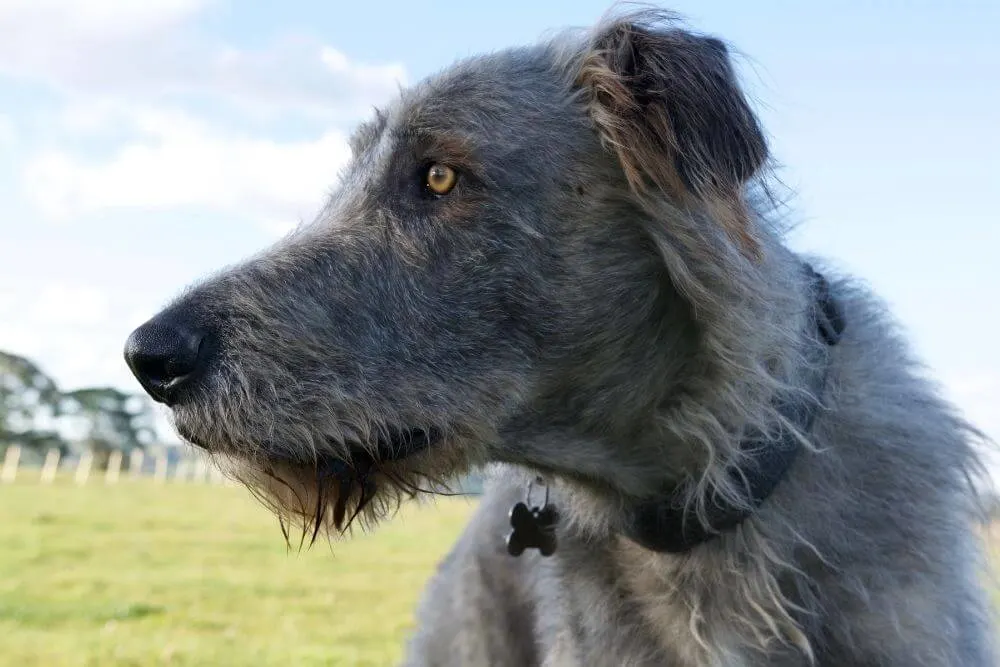
Table of Contents
- 1 The Irish Wolfhound Dog
- 2 What is an Irish Wolfhound?
- 3 Irish Dog Breeds
- 4 Facts about the Irish Wolfhound
- 5 Irish Wolfhound Dog Breed Characteristics
- 6 Irish Wolfhound Maintenance
- 7 What is the average Irish Wolfhound lifespan?
- 8 Do Irish Wolfhounds have health problems?
- 9 What do Irish Wolfhounds eat?
- 10 Do Irish Wolfhounds need a lot of exercise?
- 11 Irish Wolfhound Training
- 12 Irish Wolfhound Temperament
- 13 Irish Wolfhound Breed Clubs
- 14 Irish Wolfhound Breeders
- 15 Irish Wolfhound Cost
- 16 Irish Wolfhound Rescue and Irish Wolfhounds in Need
- 17 The History of Irish Wolfhounds
- 18 Irish Wolfhounds Today
- 19 Dog Breeds Irish Kennel Club
The Irish Wolfhound Dog
It is hard not to be impressed by the sheer size and stateliness of the Irish Wolfhound.
These tall, slender giants were the hunting dogs used by the Irish nobility in ancient times and were also prized gifts to the elite of Europe during the middle ages.
Down through the centuries they have been woven into Irish literature and culture, as well as the myths and legends.
What is an Irish Wolfhound?
An Irish Wolfhound is a very large breed of Irish dog that is thought to have ancient origins.
How ancient it is is debatable, but one of the earliest references dates back to the 4th century when a number of these dogs were given to a Roman Consul.
As the name suggests, the Irish Wolfhound was primarily used to hunt wolves who once roamed the Irish countryside.
In fact the fate of the Irish Wolfhound was inevitably bound with the fate of the wolves in Ireland.
Once wolves had been eradicated in the late 18th century from Ireland (about 100 years after the last wolf was killed in Britain), the need for such large hunting dogs was no longer as strong and the numbers drastically reduced.
The Irish Wolfhound that we know today is more of a modern breed, as there were not enough purebred animals to save the breed in the 19th century.
By crossing the best available Irish Wolfhound specimens with other breeds such as Scottish Deerhound, Captain George August Graham was able to create the Irish Wolfhound as we know it today, which is possibly larger than the original.
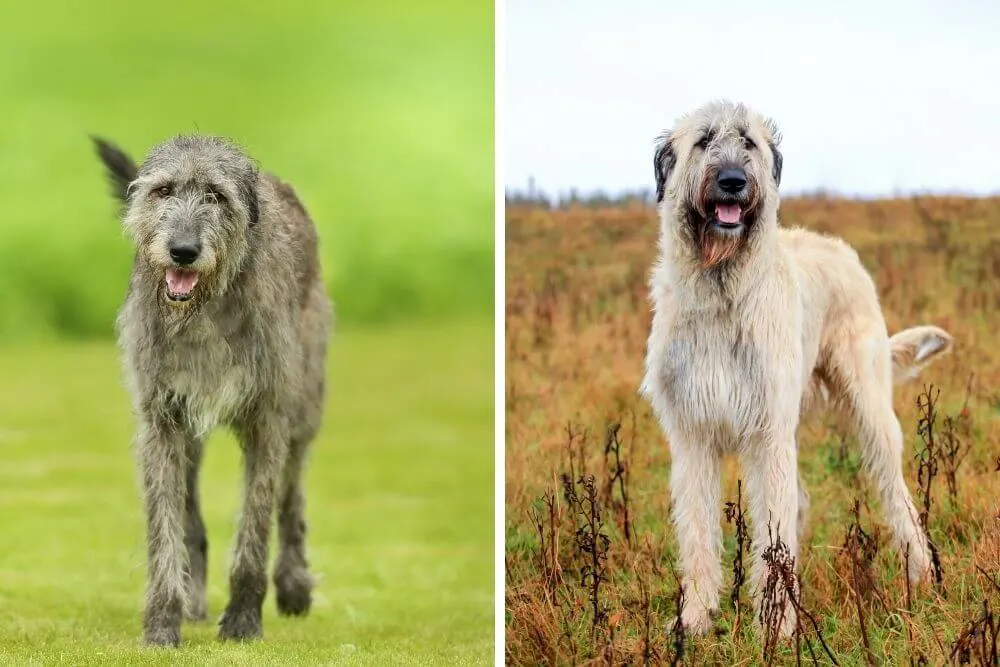
Irish Dog Breeds
There are nine Irish Dog Breeds and the Irish Wolfhound is one of them.
The other are as follows:
- Irish Wolfhound
- Kerry Beagle
- Irish Setter
- Irish Red and White Setter
- Irish Water Spaniel
- Irish Terrier
- Kerry Blue Terrier
- Irish Soft Coated Wheaten Terrier
- Glen of Imaal Terrier
One other dog type that is not officially recognized as a breed is the Irish Doodle. This is a mix between an Irish Setter and a Poodle.
Facts about the Irish Wolfhound
- Irish Wolfhounds are the tallest dog in the world typically standing over 2 meters tall (7 feet)
- Many Irish legends, as well as poetry, feature these remarkable giant dogs
- An image of an Irish Wolfhound was minted on the Irish sixpence coin before decimal coinage was introduced
- Irish Wolfhounds are resident at Bunratty Castle and Folk Park (County Limerick) and Ashford Castle (County Mayo)
- Irish Wolfhounds are the 85th most popular dog breed on the American Kennel Club ranking list
Irish Wolfhound Dog Breed Characteristics
How tall is an Irish Wolfhound?
Male Irish Wolfhounds are usually larger than females standing between 81-86 cm (32-24 inches at the withers.
The Irish Wolfhound height for males is at least 79 cm (31 in.) and 71 cm (28 in.) for females.
Although it is not good for their bodies, when an Irish Wolfhound stands on its hind legs it can reach a height of 2.1 m (7 ft), making them the tallest dog in the world apparently!
Which is bigger, a Great Dane or Irish Wolfhound?
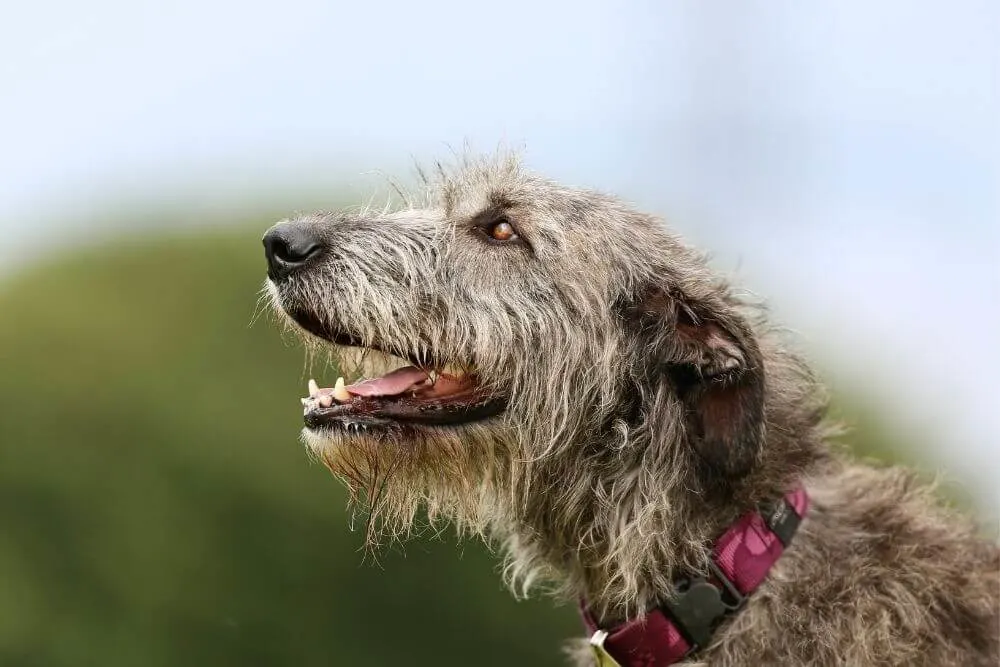
If you are wondering which is bigger, an Irish Wolfhound or a Great Dane it really does tend to depend on the individual dog.
They are generally around the same height, but Irish Wolfhounds sometimes tend to be a little taller. Great Danes tend to be bigger and are more heavily built.
The Scottish Deerhound, which is closely related to the modern Irish Wolfhound, is slightly smaller than the Irish breed.
Are Irish Wolfhounds bigger than wolves?
Given that they were bred to hunt wolves, it is not surprising that Irish Wolfhounds are typically bigger than wolves both in terms of weight and size.
As sight hounds, Irish needed to be able to outrun their quarry, but also have the physical strength to kill the animal. Although they appear slender, the Irish Wolfhound is actually very muscular and powerful.
How much does an Irish Wolfhound weigh?
Typically the weight for a male Irish Wolfhound is about 55 kg (ca. 120 lbs) and about 40 kg (ca. 89 lbs) for a female.
What does an Irish Wolfhound look like?
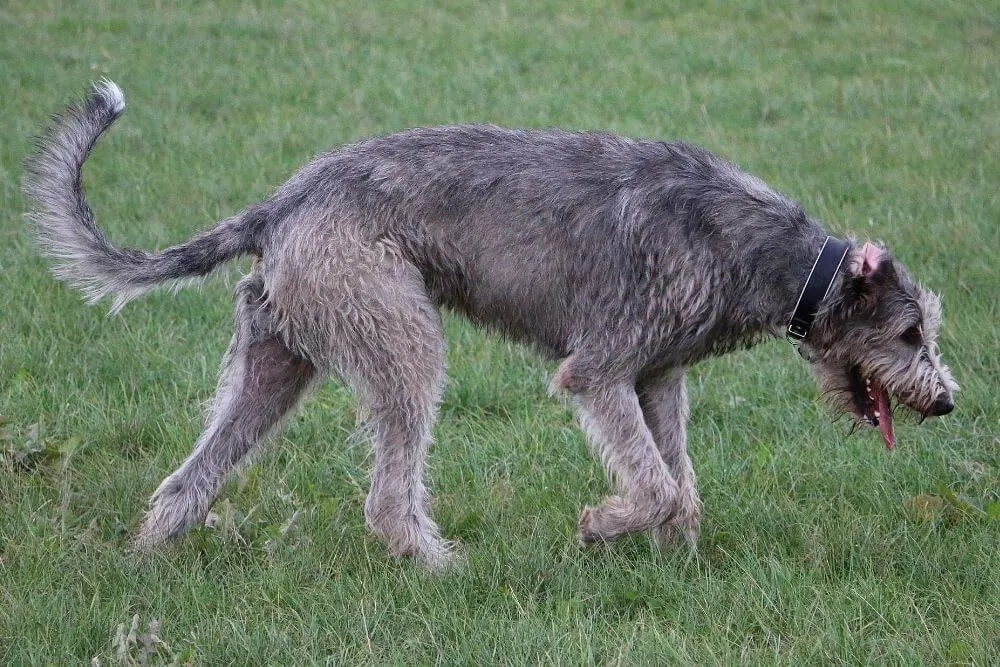
Irish Wolfhounds are large dogs with a shaggy double coat. As well as being tall in stature, they are lean and muscular and can slightly resemble a large greyhound.
They have a large head and the hair around the eyes and throat is often that bit longer than the rest of the head area.
What color eyes do Irish Wolfhounds have?
Their eyes are brown in color, but also come in other colors such as a diluted orange yellow color. The eyes of an Irish Wolfhound are their main way of hunting animals, because as sight hounds they rely on visual rather than olfactory senses.
Irish Wolfhound Coat
The coat of an Irish Wolfhound is medium in length with a rough, wiry texture, particularly the outer layer of the double coat.
Irish Wolfhound colors vary and come in many different colors including black, white, gray, blue, brindle, red, wheaten, as well as some mixed variations of those mentioned.
Their coats can also have some markings in colors like black, white or gray.
What do Irish Wolfhound puppies look like?
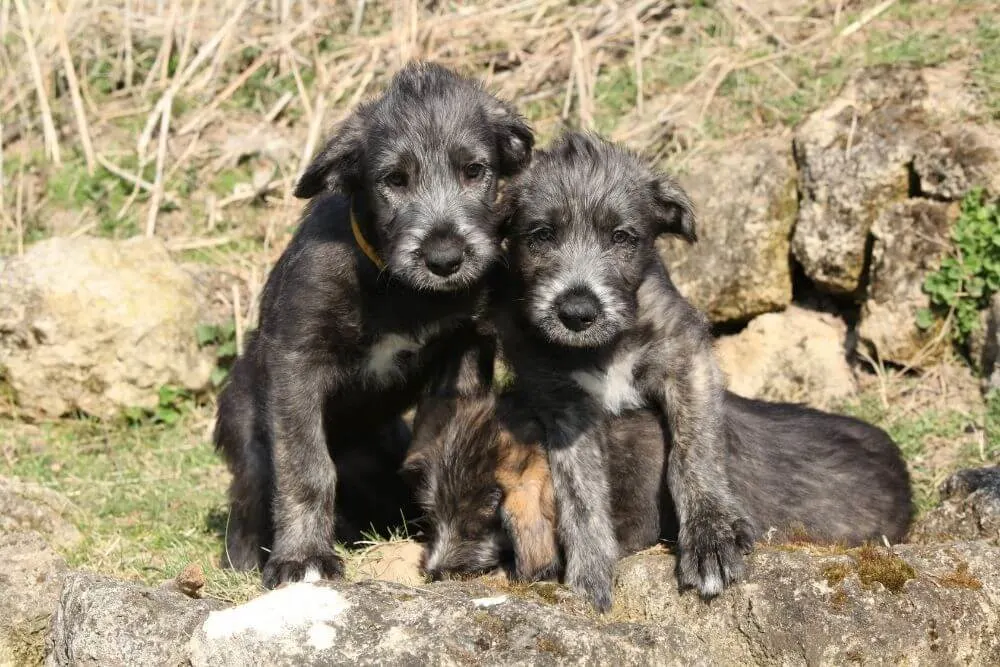
It takes time for Irish Wolfhound puppies to mature into an adult Irish Wolfhound.
During their first few months, they tend to be a little gangly and clumsy as they learn to adjust to their rapidly growing frame.
It helps not to put excess pressure on their joints at this delicate stage so as to prevent damage in later life.
What dogs are similar to an Irish Wolfhound?
As Irish Wolfhounds were outcrossed with other breeds to prevent their extinction in the 19th century, there is still a notable resemblance to some of these breeds.
Scottish Deerhounds are quite similar to the Irish Wolfhound, although usually smaller in size.
Other dogs that share similar features are the Great Dane, Whippet and the Greyhound.
Irish Wolfhound Maintenance
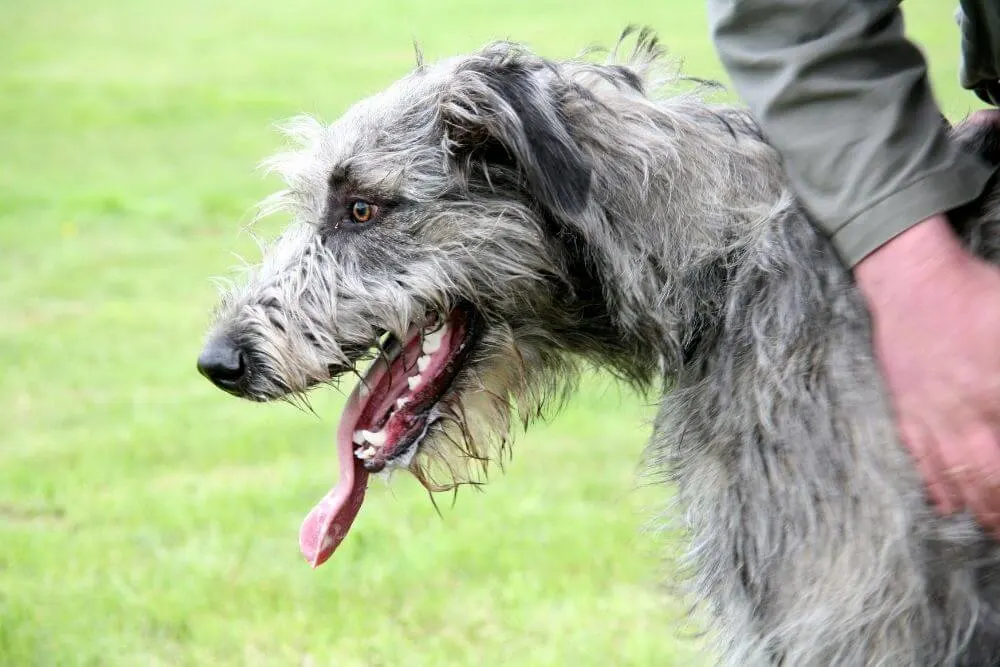
As large dogs, Irish Wolfhounds need maintenance to keep them healthy and in good shape.
To avoid any problems with their paws, the nails of the dog should be regularly checked and trimmed when they are too long.
It is best to do this frequently and to gradually shorten longer nails rather than cutting too much off at once.
As this is something that many dogs really don’t like, start gradually and help your dog associate this with a positive experience.
Dental care is important, so brushing the teeth of the Irish Wolfhound using a specially dog toothpaste weekly basis will help to reduce the buildup of plaque and other dental issues.
The ears of the Irish Wolfhound are small, but they usually neatly fold over upon themselves.
This means that dirt, moisture and heat are likely to get trapped inside and could lead to an excess of wax or other ear problems that are likely to cause the dog discomfort and pain.
Regular ear checks and cleaning can prevent these issues from occurring.
Do Irish Wolfhounds need much grooming?
As part of their pet care, every week Irish Wolfhounds should get a thorough brushing to remove dirt, debris and loose hair.
(Always keep a close eye out for ticks as well as they can easily hide in the coarse hair.)
Two to three times a year the coat of the Irish Wolfhounds should be stripped.
This is a slow and time consuming procedure, which you can either learn to do yourself or get the help of a professional groomer.
Either way it is best to start training the dog early so that it becomes familiar with the procedure.
Do Irish Wolfhounds shed?
Irish Wolfhounds do shed, but usually not very much. To keep shedding to a minimum, it is best to regularly brush (weekly) and strip (2-3 times a year) the coat when required.
Are Irish Wolfhounds hypoallergenic?
No, the coat of this breed is not considered to be hypoallergenic.
If you suffer from allergies, you should get expert advice about which dog breed would be best suited to your requirements.
Do Irish Wolfhounds drool?
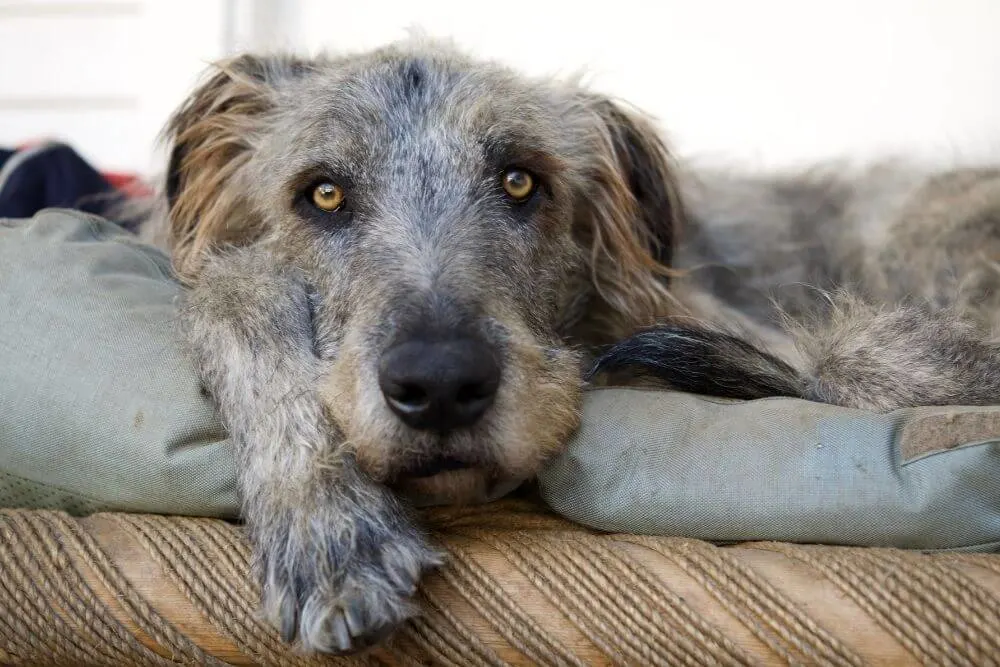
Irish Wolfhounds are not known for excessive drooling, although they may slobber slightly when they get very excited or when drinking or eating.
How often should I bathe an Irish Wolfhound?
Generally, Irish Wolfhounds should not be bathed very regularly.
Every three months would be ideal, but this can be done on a 4-6 week interval if necessary.
By bathing too frequently, it is possible to cause skin issues with the dog.
Always use special dog shampoo, ideally for wire haired dogs, and follow the directions to get the best results.
Are Irish Wolfhounds better suited to a cold or warm climate?
Irish Wolfhounds are suited to cool, rather than cold climates.
Ireland has a cool oceanic climate, which means that the weather in Ireland is usually not too hot or too cold and suits these dogs very well.
While the coat of the Irish Wolfhound does insulate them, they are not well adapted to either extreme cold conditions.
Very hot weather will also not suit dogs like the Irish Wolfhound, so be sure to keep them cool and give plenty of water if the temperatures get uncomfortably high.
What is the average Irish Wolfhound lifespan?
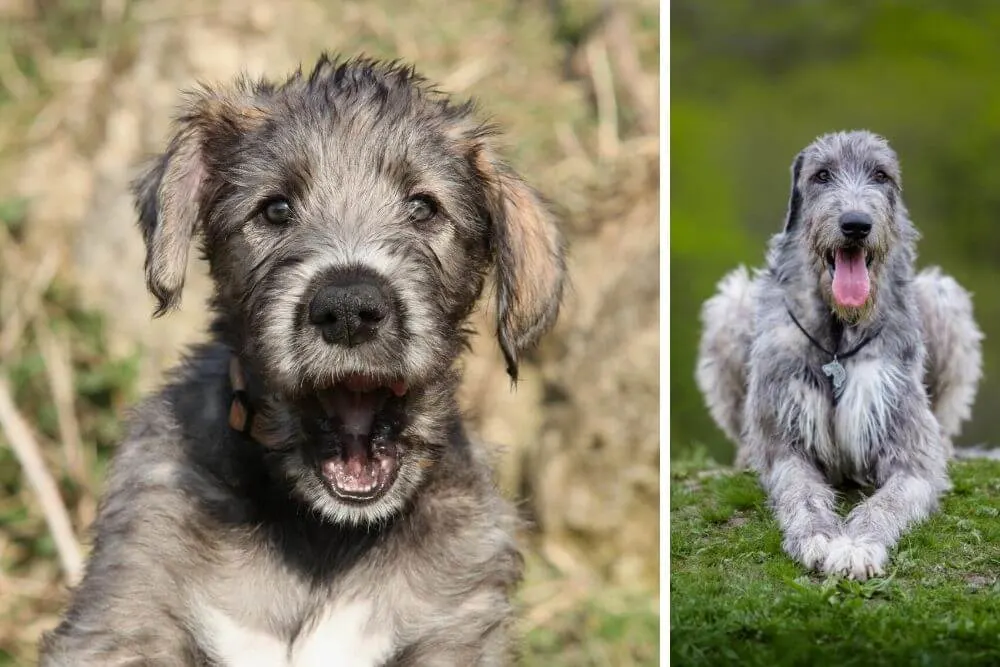
The life expectancy of Irish Wolfhounds is usually somewhere between 6-10 years. Animals that live longer than about 8 years are seen as quite old.
Why do Irish Wolfhounds only live for a short time?
Large dogs, such as the Irish Wolfhound, usually have shorter lifespans than smaller animals.
Health issues are typically the cause of the early deaths in Irish Wolfhounds with dogs typically living to be about 7 years on average.
When reflecting on the purpose of this breed, it was used for the dangerous and risky task of hunting large animals.
They needed to be fit, energetic and probably young to be capable of this task. It is also likely that old animals who were no longer capable of hunting were not of much use to their owner and would have been costly extras.
What is the oldest recorded Irish Wolfhound?
The oldest recorded Irish Wolfhound “Killykeen Kildevin” lived to be an impressive 16 years and 6 months, but this is highly unusual.
More information about Irish Wolfhound longevity can be found in a report by the Irish Wolfhound Club of Ireland.
How long does it take for Irish Wolfhound puppies to mature?
It can take between 2 or even 3 years for an Irish Wolfhound puppy to fully mature.
During that time, the dog can often be clumsy and awkward.
Depending on the dog, there may also be destructive tendencies, so it is always best to start training good behavior and setting clear rules from early on.
Do Irish Wolfhounds have health problems?
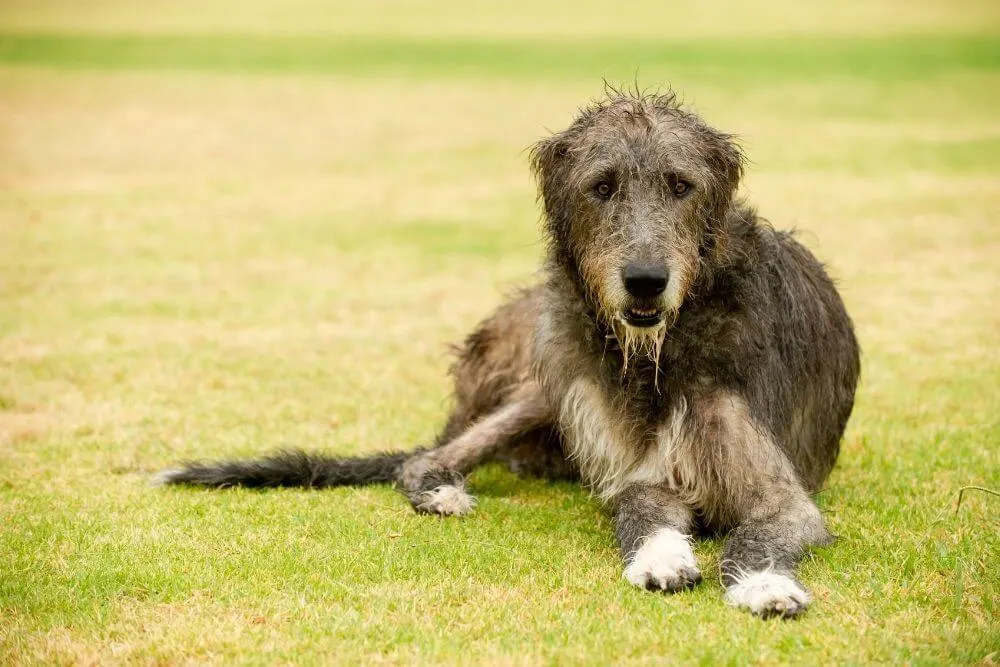
Irish Wolfhounds are known to have some health issues, some of which are genetic, so it is important that they are regularly checked (at least once a year) by a veterinary specialist to catch any health issues as early as possible.
One of the words used to describe Irish Wolfhounds is stoic, and a dog may not easily indicate if something is up with their health.
It is therefore imperative that their owners should always be on the lookout for any unusual signs or symptoms that could indicate health problems.
One of the main health issues is bone cancer.
Bloat is another concern, which is why the animals should not be fed directly before or after intense exertion (this can help reduce the risk of bloat occurring). This can occur suddenly and can be fatal if not treated promptly.
Other issues diagnosed with Irish Wolfhounds include heart disease, liver shut, hip dysplasia, pneumonia, Von Willebrand disease, megaesophagus and eye issues.
As the puppies tend to develop very quickly, excessive exercise should be avoided to reduce the chance of causing damage to the growing bones and delicate joints.
Soft bedding and places to relax will help to avoid the likelihood of developing bursitis (painful bumps on the outside of their joints).
If you are in doubt about the health of an Irish Wolfhound, it is always best to seek the opinion of a veterinarian as soon as possible.
What do Irish Wolfhounds eat?
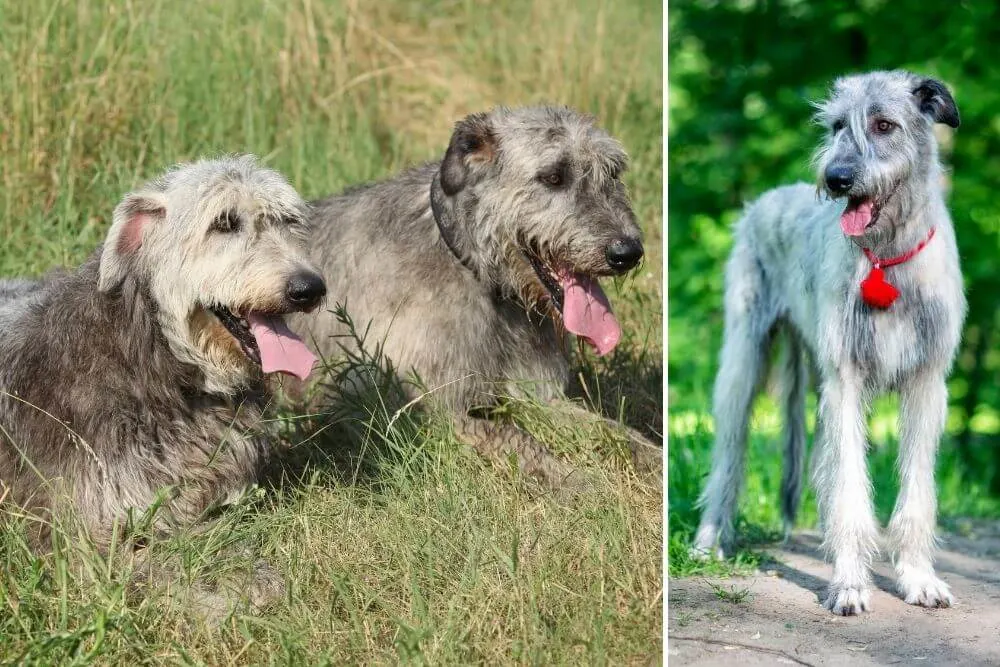
Irish Wolfhounds should eat high quality dog food that is specially formulated for larger dogs and their nutritional needs. It is also important to get the right type of dog food for their age.
Activity level, age, gender and whether the animal has been neutered or spayed can also play a role in determining the diet and correct amount of food to give your dog and this should ideally be discussed with a specialist who can guide you in these matters.
Due to the rapid growth of puppies, they require the right amounts of food to deliver the nutrients that their growth bodies need.
Achieving the right balance of nutrients such as calcium and phosphorus, which impacts on bone health, are essential and should be done with the guidance of your vet.
Planning feeding time into the daily routine is important as it should not be before or directly after exercising to reduce the likelihood of bloat.
Due to their large size, Irish Wolfhounds do eat considerably more than small dogs, which should be factored into their overall maintenance and upkeep costs.
Do Irish Wolfhounds need a lot of exercise?
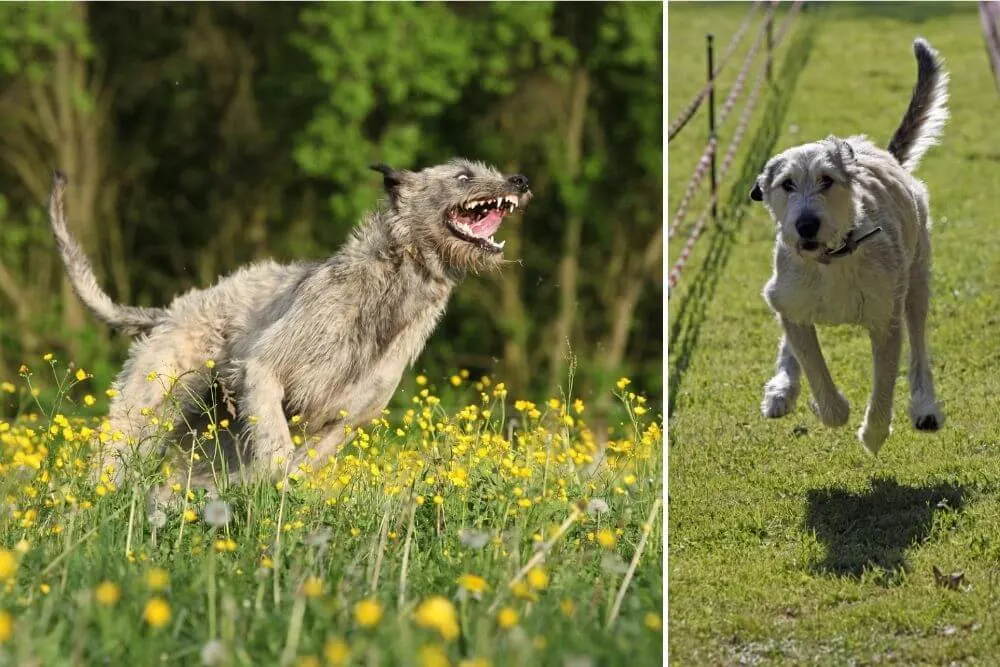
Irish Wolfhounds are large, but they have moderate exercise requirements. Generally about 1-2 hours of activity daily is needed to make sure they stay in good shape and healthy.
This dog care exercise should consist of walks, but also time where the dog can run free in a (safe fenced yard). This allows them to gallop around and burn off their energy in a healthy way.
There is a fine balance to ensuring that an Irish Wolfhound gets the right amount of exercise, but that their bones and joints do not become stressed.
This is particularly the case when the dog is still a puppy.
Do Irish Wolfhounds need to be on a leash?
It is advisable that Irish Wolfhounds are placed on a leash when out and about.
As sight hounds, they have a natural instinct to chase anything that moves.
Without the necessary training, which should start at a young age, the dogs are likely to pursue the moving object without any thought for its owner.
They are strong and muscular dogs and can sprint at speeds of somewhere between 48-65 kmh (30-40 mph).
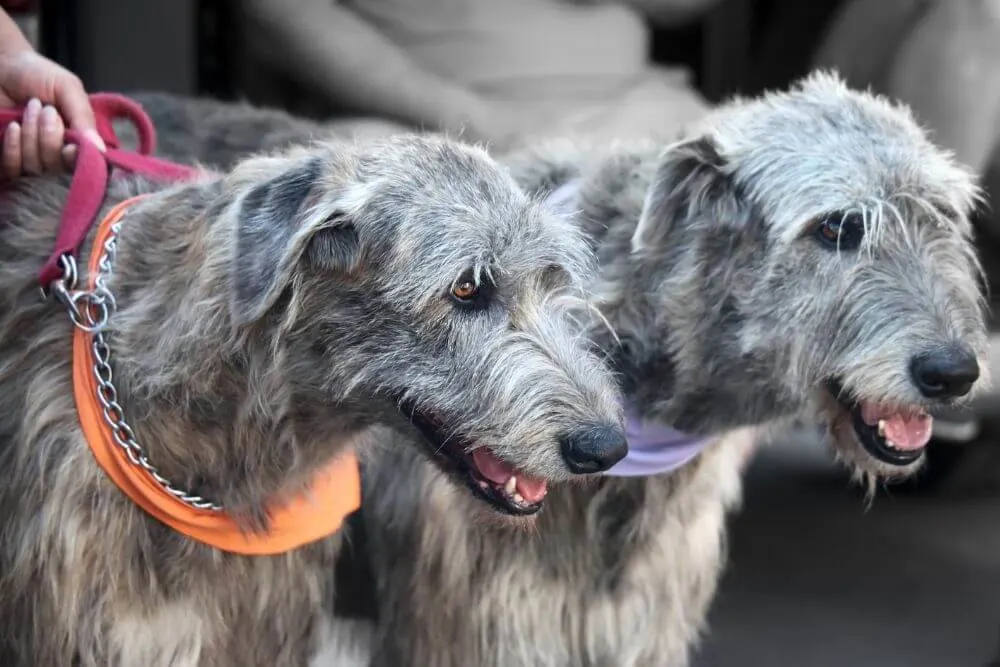
While Irish Wolfhounds are not typically aggressive and can often be friendly towards strangers, their sheer size can make people, especially children, feel uncomfortable and are best kept close to their owners when in public areas.
Do Irish Wolfhounds like water?
Some Irish Wolfhounds enjoy being in water, especially wading in it, however individual dog preference may differ.
While Irish Wolfhounds can swim if required, their long, large bodies are not ideally suited for swimming and they are not typically known for this activity.
The Irish Water Spaniel on the other hand, is known for its love of water and special adaptations including webbed feet that help them hunt in water and wet environments such as marshes and bogs.
Irish Wolfhound Training
Irish Wolfhounds were bred to hunt sometimes at great distance from their owners, so they needed to rely on their own independent judgment in some circumstances.
It is true that there is still a degree of independence in an Irish Wolfhound, so it is best to approach their dog training in a firm, consistent and yet respectful way.
Are Irish Wolfhounds hard to train?
Irish Wolfhounds are intelligent, fast learning dogs who need a clear master to help them maintain their good discipline. Irish Wolfhounds respond best to trainers who set out clear rules and use friendly, yet strict directions in a consistent manner.
It is very important to start training the dogs at a young age. Ideally, the dogs should know many of the basics, such as walking beside you on a leash before they become stronger than you!
Early socialization to people, including strangers and children, is required for the dogs to build up a connection to others and lifelong confidence in different situations.
The same can be said about the introduction to other animals and household pets.
Generally, if this is done at an early enough age, most Irish Wolfhounds can get on well with other pets in a family, but this of course can vary from dog to dog.
Do Irish Wolfhounds take part in canine sports?
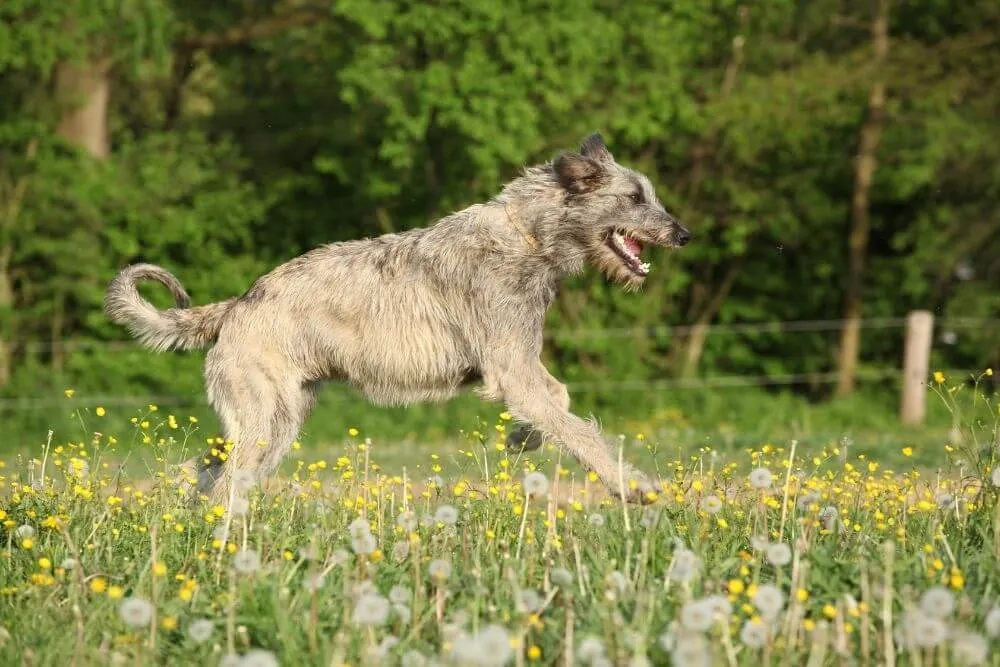
Irish Wolfhounds regularly take part in dog sports such as agility, tracking and obedience competitions.
They are also well suited to lure coursing. More specific dog breed information about these sports, including upcoming events and meetups can often be found on the national breed club sites.
Do Irish Wolfhounds bark a lot?
A well balanced Irish Wolfhound is unlikely to bark a lot.
These dogs by nature do not bark excessively and when they do, it might be a sign that something might be up. It is worth taking a look at their exercise regime to see if they are getting sufficient movement to burn off their energy on a daily basis.
Dogs that are left at home alone for long periods are also likely to miss their owners and might become destructive and noisy.
Irish Wolfhound Temperament
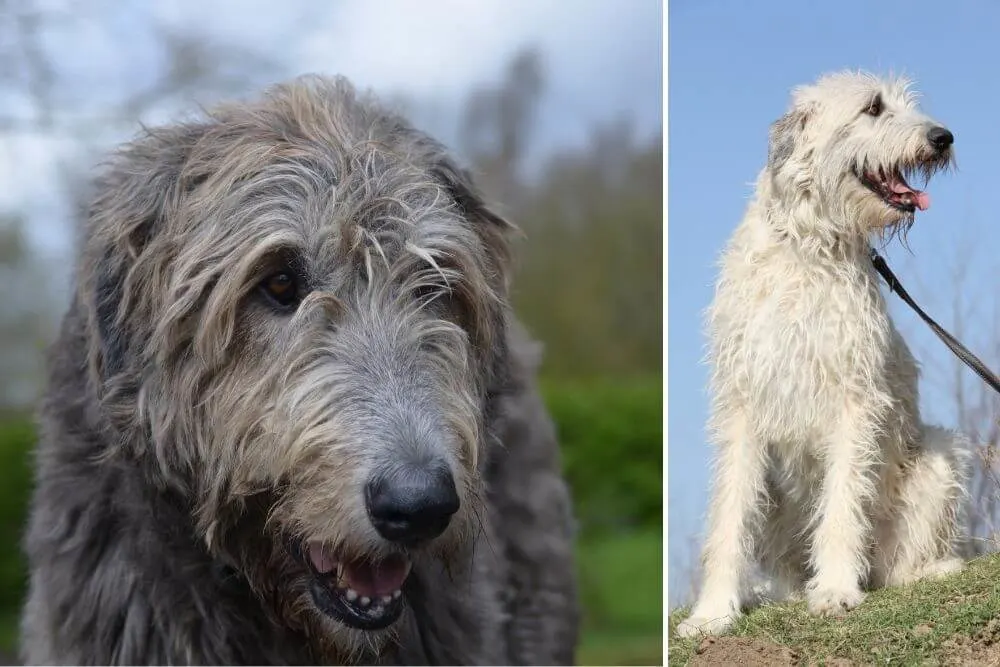
Although these dogs are large, they are known for being gentle and calm under most circumstances.
Irish wolfhounds often have a mellow, easygoing personality and take life in their stride with plenty of patience and no need for urgency with most things.
Dogs that have been socialized with people and animals early in their lives are less likely to have problems with confidence, aggression or shyness.
Training at this early stage of their lives is essential to make sure the dog gets a good social foundation for life.
Irish Wolfhounds are loyal and protective.
The strong bond that they form with their families is an enduring one, which means they are not necessarily the most adaptable and do not always cope well with a change of owner.
Their strong ties also make them vulnerable to loneliness if left alone for lengthy periods.
Their affable nature is one of the traits that makes them generally unsuitable as a watchdog or guard dog.
Particularly during their early years, these dogs need time to find their feet.
Not only do they tend to be gawky and uncoordinated at times, they also can be destructive if not given the right amounts of input (physical, mental and of course, emotional).
As puppyhood can last 2 years (or even a bit more in some cases), this is a big chunk of the life of a dog that typically lives only to about 7 years of age.
Are Irish Wolfhounds good pets?
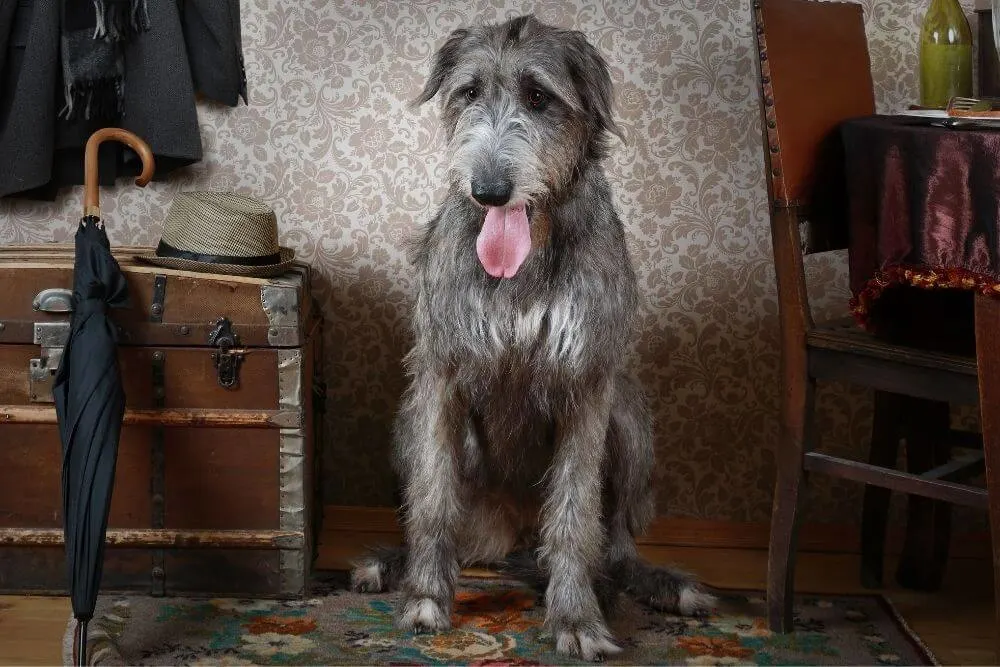
The sweet tempered nature of the Irish Wolfhound makes these gentle giants very lovable pets.
They do not usually have aggressive tendencies and typically get on well with people and animals.
They form a close affectionate relationship with the people who they see very regularly and make good family pets.
The fact that they also can get on with other dogs, and other household animals means that they could be a good addition to a family.
Basic things to consider before getting an Irish Wolfhound as a pet include:
- Sufficient Space: These dogs need space both indoors and outdoors to get them the freedom that they need to stay fit and healthy. A large, well fenced outdoor space that the dogs can run and stretch their legs in is important. The dog should also have a roomy home indoors, a small apartment is just not suitable for such a large dog.
- Exercise and Maintenance: All dogs require time commitments in terms of daily exercise and regular maintenance, Irish Wolfhounds definitely require considerable and consistent inputs from their owners throughout their lives.
- Regular Health Checks: In terms of health, while these dogs are hardy, they do tend to suffer from a variety of health issues which leads to regular and potentially costly veterinary visits.
- Additional Costs: It is also worth mentioning that these dogs need other, sometimes less obvious resources that not every family may account for. Suitable space in a car if you need to transport the dog from one place to another, as well as of course the costs associated with food, grooming and bedding for a larger animal, as well as pet insurance.
- Short Lifespans: Irish Wolfhounds do not have very long lifespans, this can also be an influencing factor for some people when opting for the most suitable family pet.
So while yes, Irish wolfhounds are good family dogs, not every family has the time, space and money to give an Irish Wolfhound the best possible home.
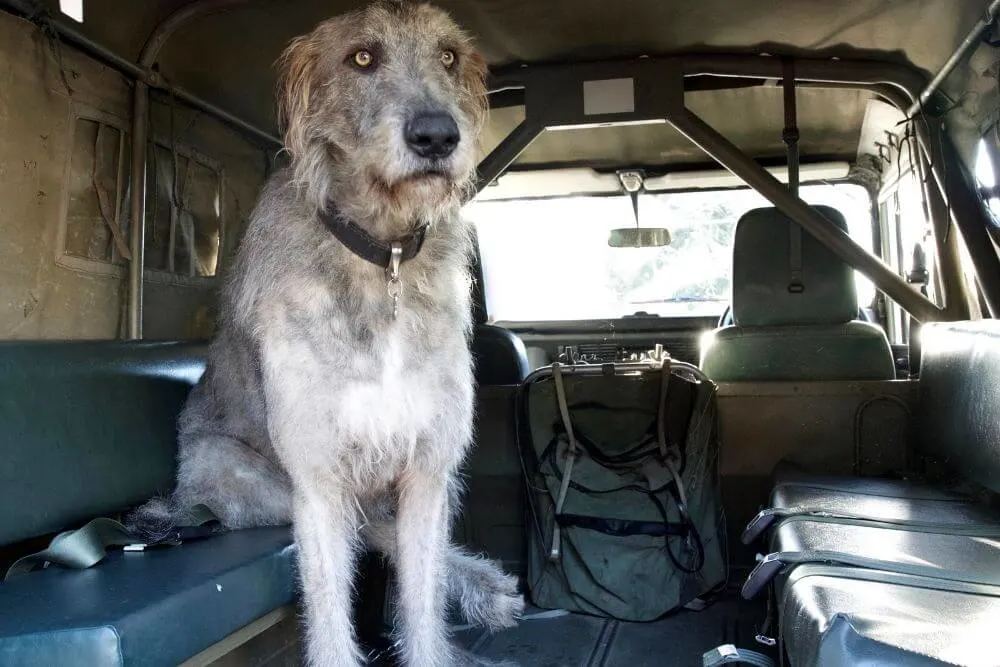
Are Irish Wolfhounds good with children?
Irish Wolfhounds that have been around children from a young age are usually well accustomed to the rough and tumble in a household with youngsters.
Their gentle nature is well suited to children, especially older ones who know how to respectfully play with dogs.
Children, particularly younger ones, might be a bit overwhelmed by the size (and strength) of Irish Wolfhounds.
This is true in the family home, but also when out and about with these giant dogs, which is another reason why a leash is essential in public.
The Irish Wolfhound size resembles that of a small pony and it is not unknown for children to attempt to ride on the backs of Irish Wolfhounds.
This could cause serious damage to the dog and should be permitted.
Are Irish Wolfhounds good with other dogs?
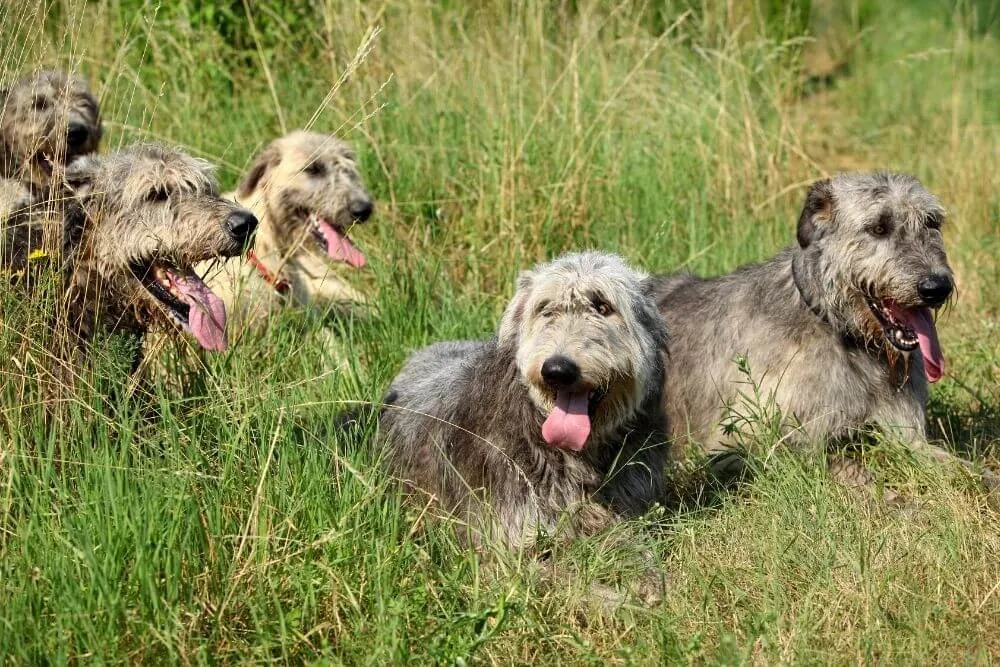
Generally, Irish Wolfhounds get on well with other dog breeds if they have been exposed to them from an early age.
Early socialization to other dogs and animals from the young puppy stage is very important.
This enables Irish Wolfhounds to gain knowledge and experience of different settings that will help them navigate different challenges that they will be presented with throughout their lives.
In some cases, Irish Wolfhounds may not get along with dogs of the same sex and can be dominant.
If you are wondering whether Irish Wolfhounds are good with cat breeds and other pets, the answer is the same.
Irish Wolfhounds that receive early socialization with other animals are best likely to tolerate later in life, including cats. However, there may still be a strong instinct in Irish Wolfhounds to chase smaller animals that run, so how well they get on depends on the individual dog.
Are Irish Wolfhounds good apartment dogs?
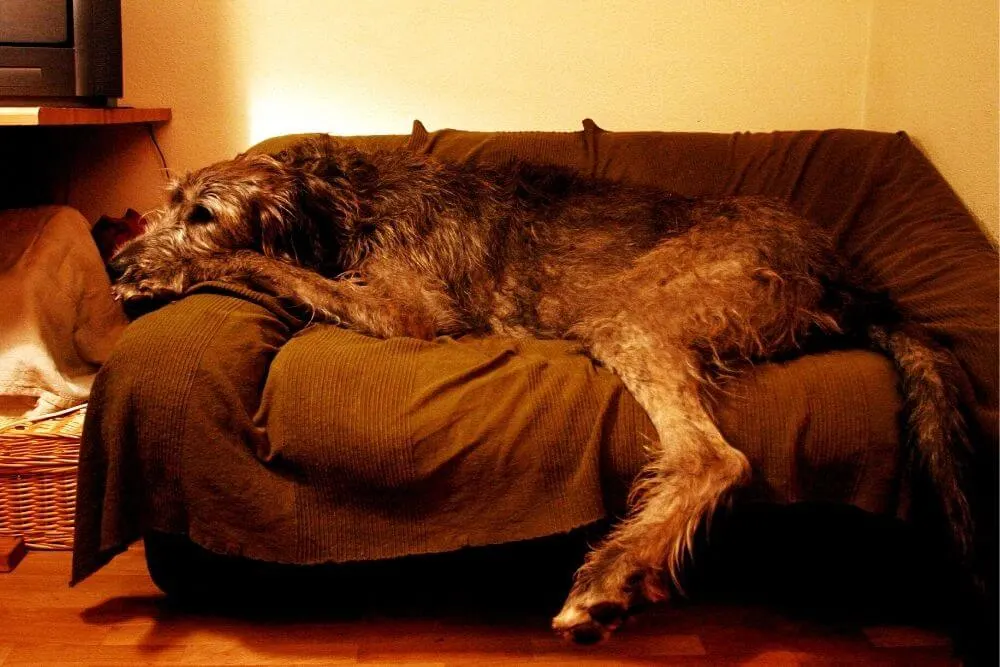
While some breeds of small dogs can happily live in cozy apartments, the Irish Wolfhound needs more space to roam and lounge around.
They are best suited to large, flat indoor areas because due to their body shape, their size makes walking up and down stairs tricky.
Can Irish Wolfhounds be left alone?
Due to the strong bonds Irish Wolfhounds form with their owners, it is not advisable to leave them alone for long periods on a regular basis.
This can lead to some separation anxiety and destructive tendencies, such as chewing or excessive barking. They are best suited to owners who can be in close proximity to them most of the time.
Are Irish Wolfhounds good guard dogs?
While the size of the Irish Wolfhound may be intimidating and act as a deterrent, Irish Wolfhounds are not considered to be good guard dogs as they are not typically aggressive and wary of strangers.
In terms of being a watchdog, Irish Wolfhound are very vigilant and will notify their owner of the arrival of a stranger.
However, strangers are very often warmly welcomed by many Irish Wolfhounds, which limits their use as a watchdog. (Some dogs are naturally more wary of strangers than others though.)
Are Irish Wolfhounds protective?
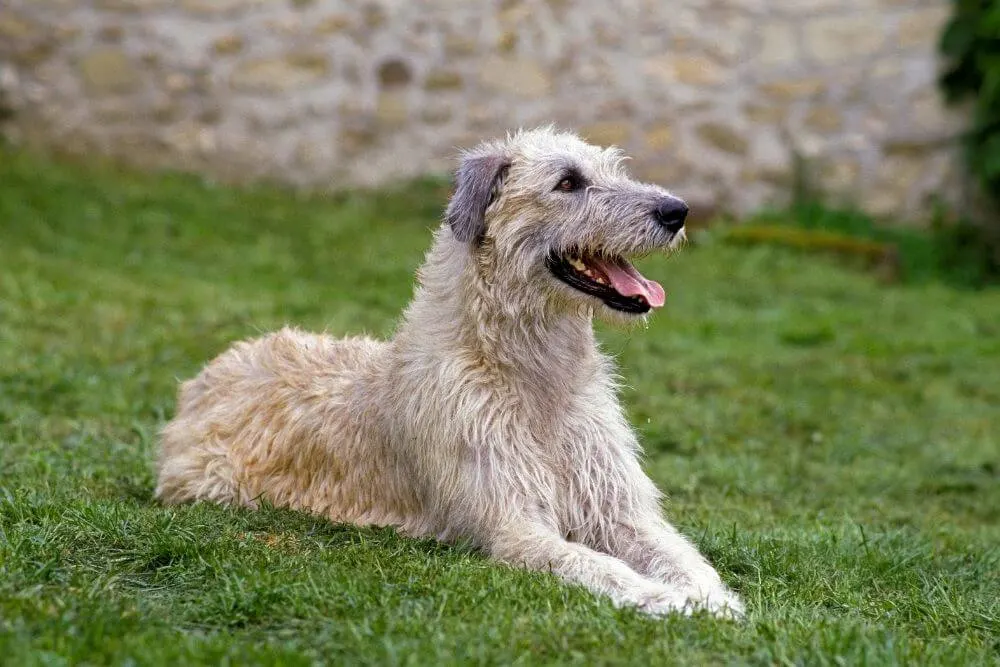
Known for their loyalty, Irish Wolfhounds are likely to act in a protective manner if their owners are threatened.
However, when it comes to protecting and defending property, Irish Wolfhounds do not score highly at all. Most of the time they are very easygoing and even avoid confrontation if possible.
Are Irish Wolfhounds aggressive?
Aggressiveness is not a very common trait in Irish Wolfhounds. They are known for their chilled, laid back approach to life and generally friendliness to others.
During the first three years of life, Irish Wolfhounds are lively, jumping bundles of energy that may become aggressive and destructive if they do not receive the necessary inputs in terms of training and exercise.
Rarely do Irish Wolfhounds display aggressive tendencies and if so it is necessary to see if the animal has a balanced lifestyle with the correct amounts of exercise and stimulation, as well as love and attention that they require.
Irish Wolfhound Breed Clubs
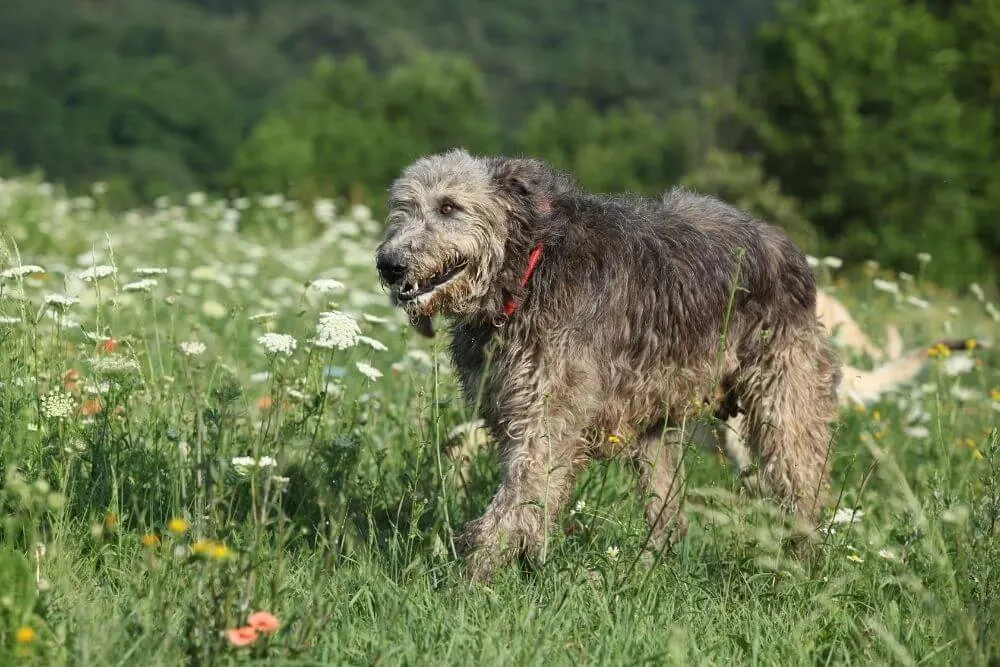
There are many Irish Wolfhound breed clubs all over the world, which just shows how devoted the owners of this breed are to supporting and encouraging fellow owners, promoting the breed and holding events for Irish Wolfhounds.
For those of you based in the USA, the Irish Wolfhound Club of America has a very extensive list of the clubs in the States, as well as many of the international clubs.
Some of the other main clubs include:
- Irish Wolfhound Club (UK)
- Irish Wolfhound Society (UK)
- Irish Wolfhound Club of Ireland
- Irish Wolfhound Society of Ireland
- Irish Wolfhound Club e.V (Germany – this article is also available in German – Irischer Wolfshund)
- Irish Wolfhound Club of Canada
- Irish Wolfhound Club of Victoria (Australia)
- Irish Wolfhound Club of New South Wales (Australia)
- Irish Wolfhound Club of South Australia Inc. (Australia)
Irish Wolfhound Breeders
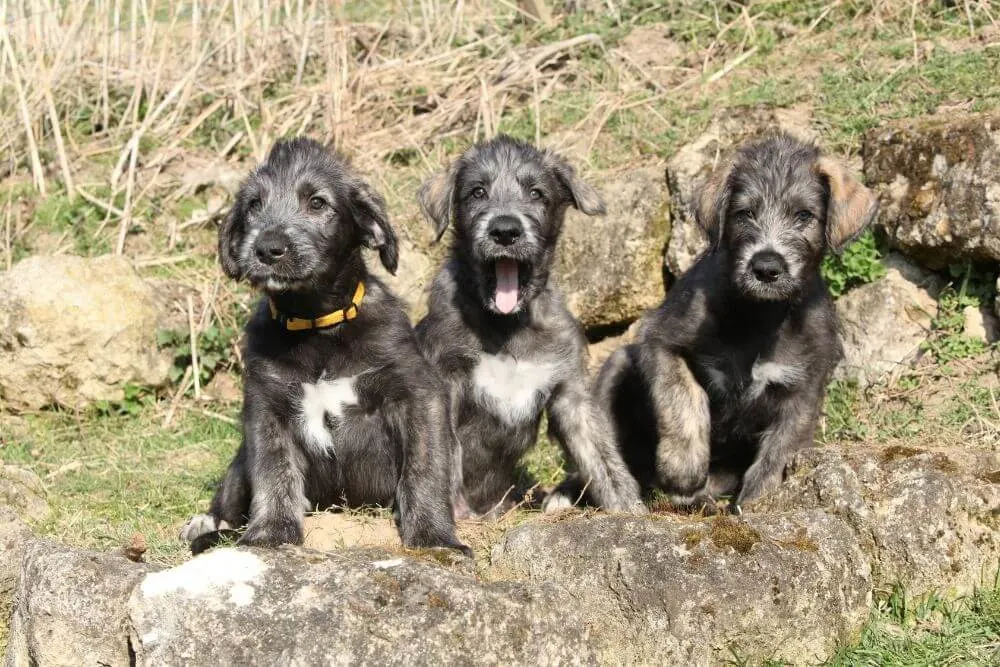
Please be sure to only look for breeders on the breed club websites and Kennel Clubs and do some homework to research your breeder.
It is also important to visit the breeder and see the mother (or even pet parents in some cases), as well as the conditions and facilities the dog was raised in before purchasing one. For information about puppy farming and how to avoid it, the Irish Wolfhound Club has some tips.
When in doubt, do not go through with the purchase and you inform your nearest breed club about your concerns.
For an idea of what type of questions to ask when deciding on a breeder, the Irish Wolfhound Club of Canada has an extensive list of questions that can help.
The following links will help you find out who breeds Irish Wolfhound puppies in your area.
- American Kennel Club (Marketplace)
- Irish Wolfhound Club of America (Breeder Directory)
- The Kennel Club (UK Marketplace)
- The Irish Wolfhound Club (Contacts)
- Irish Wolfhound Club of Ireland (Enquiries)
- Irish Wolfhound Club of Canada (Breeders)
- Irish Wolfhound Club of South Australia Inc. (Contacts)
Irish Wolfhound Cost
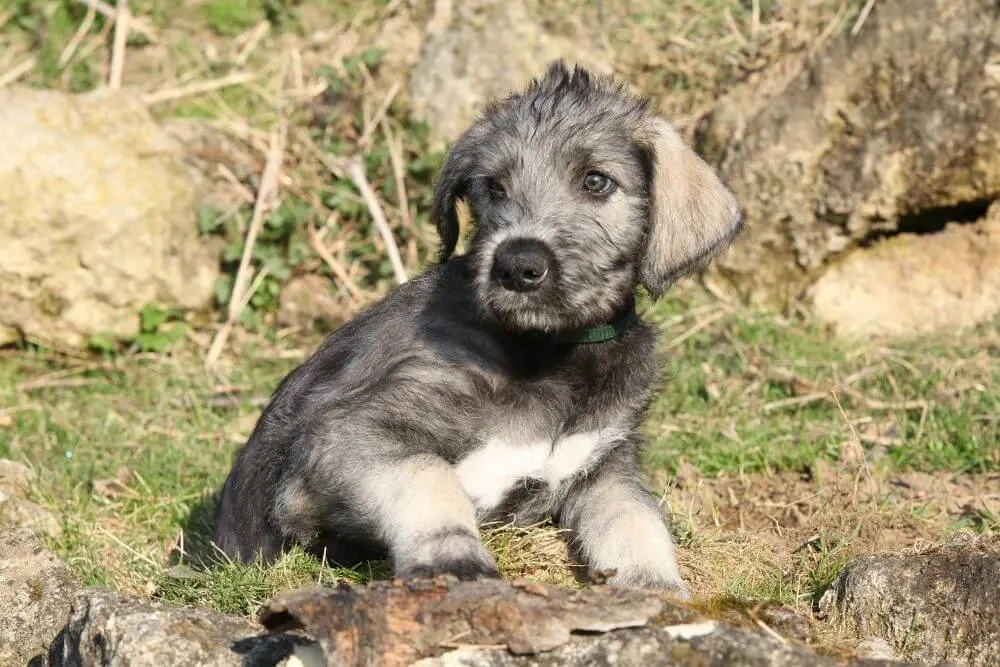
Anyone looking for a pedigree Irish Wolfhound for sale should be prepared to pay a high Irish Wolfhound price from a reputable breeder.
The price of an Irish Wolfhound may vary considerably, with factors such as bloodline, gender, location and availability.
Generally, Irish Wolfhound puppies cost between US$1500 and US$2500, but for show dogs or dogs that you plan on breeding with, the price will be higher.
Be exceptionally wary of cheaper offers. In some cases, there are advertisements offering cheap puppies for sale.
These are often scams or potentially puppy farms where the welfare of the dog has not been prioritized.
Irish Wolfhound Rescue and Irish Wolfhounds in Need
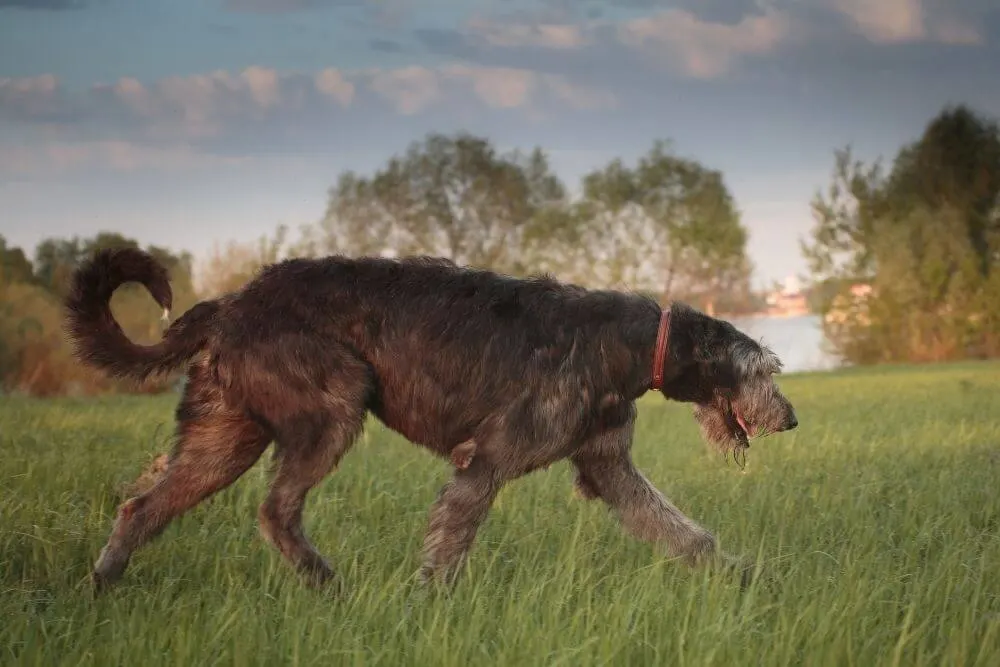
For different reasons, Irish Wolfhounds sometimes need to be rehomed.
Irish Wolfhound rescues and adoptions are sometimes available via the breed clubs, so it is worth getting in contact with one, if you think that this is a possibility for you.
If you can fulfill all of the necessary criteria, your name will be put on a waiting list.
These clubs usually request a donation to cover the costs of rehoming and all the paperwork.
Contacts for Irish Wolfhound rescues and rehoming are found in the following links:
The History of Irish Wolfhounds
Irish Wolfhounds are one of the two breeds of Irish hounds, the other being the Kerry Beagle.
It is fair to say that Irish Wolfhounds have been present on the island of Ireland for many centuries and their presence is woven into Irish folklore and culture.
They were useful, if not essential, animals that hunted wolves that roamed the Irish countryside in the times of the Celts and Chieftains of Ireland.
The history of this romanticized breed is complex and the Irish Wolfhound that we know today, almost never existed were it not for the determined perseverance of one man dedicated to the breed, Captain George Augustus Graham.
Wolfhound Dog Origins
Tracing the origins of the Irish Wolfhound through time is not completely straightforward.
What is certain is that large hunting hounds have been present in Ireland for many centuries.
Celtic Hounds
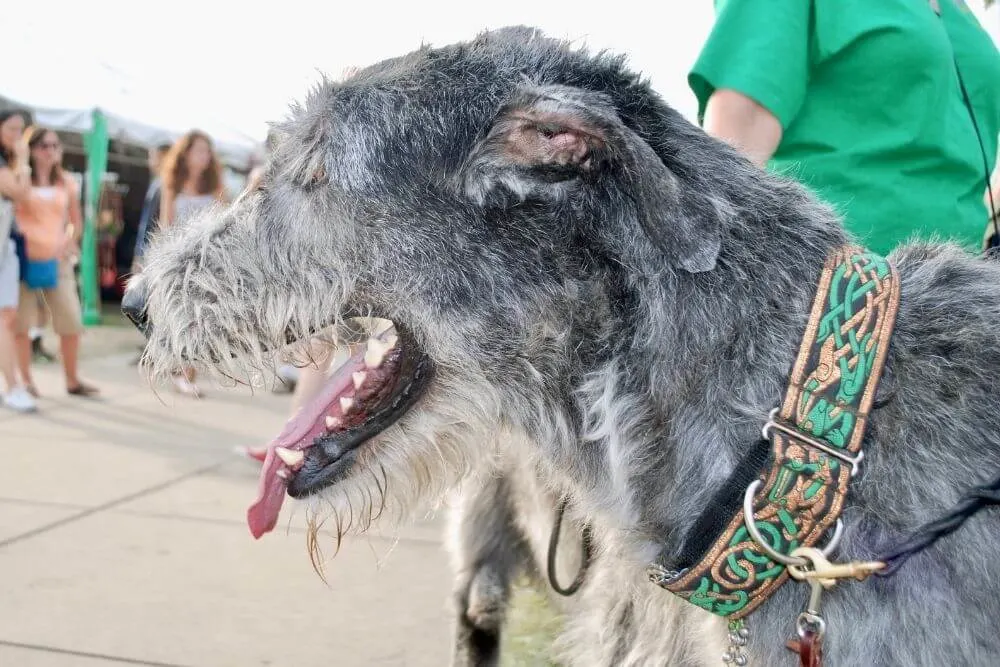
It is known that the Celts bred large dogs that were used to defend valuable livestock against threats such as wolves or raiding parties.
This was particularly important in a society that measured wealth often in terms of cattle and other livestock.
There is also some mention of the Celts using large dogs in battle, such as the one in Delphi in Greece in 279 BCE.
The Celts arrived in Ireland around about 500 BCE and brought with them many things, including their culture and art (Celtic Symbols and Celtic Knots), so it is highly possible that they brought their Celtic dogs with them too.
One of the first known records of Irish Wolfhounds comes from the writing of a Roman Consul in the 4th century.
It appears that Quintus Aurelius Symmachus was given several large dogs that he called “canes Scotici”. (Don’t be confused by the name, “Scoti” was the term given to the Irish known as Gaels living in Ireland at the time.)
Aurelius Symmachus wrote that when these dogs used to fight wild animals at events for the public, the audience were amazed by the dogs, the likes of which they had not seen before.
These dogs were so valued that their ownership was also stipulated under the old Irish Law system known as Brehon Law or Féineachas.
Ownership of these dogs was restricted to the upper tiers of society and there were strict rules as to how many one person could own. It is said that the High King of Ireland, Cormac Mac Airt had 300 hounds.
Irish Wolfhound in Folklore and Poetry
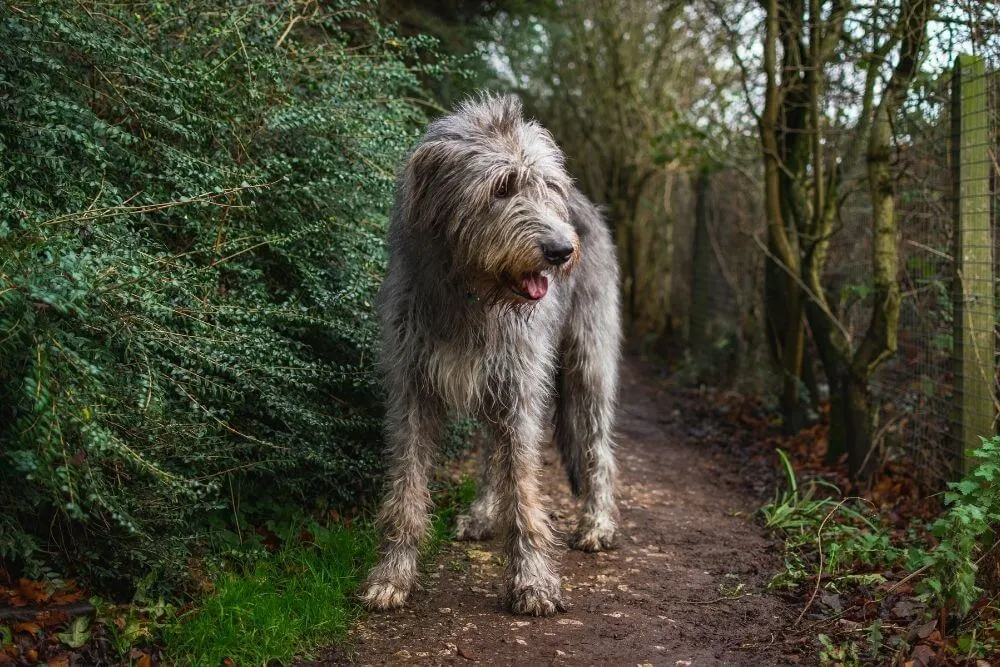
As the Irish Wolfhound has such a striking appearance, it is little wonder that they have captured people’s imaginations and featured in folklore and poetry. Here are some of main examples:
The famous warrior Cú Chulainn also owes his name to a large dog, which was possibly a kind of wolfhound (or cú faoil in Irish). As a child Cú Chulainn was known as Sétanta.
After he killed the hound (“cú” in Irish) of Culann in self defense, he volunteered to personally defend Culann and his property until another dog could be found to replace him.
Upon this promise, Sétanta became the Hound of Culainn or Cú Chulainn.
Fionn mac Cumhaill, one of the most well known figures from Irish mythology supposedly had two Irish Wolfhounds.
The Irish Wolfhound named Bran was male and the female was Sceólang.
These dogs rarely left his side and as the legend has it, they were born of a human mother who was transformed into a dog.
Gelert, was the name of the Irish Wolfhound that was given to Llywelyn, the Prince of Wales by King John of England in 1210 and is the subject of the poem, Beth Gêlert, written by William Robert Spencer.
It tells the tale of the Prince mistakenly believing that his Wolfhound took his sleeping child from the cradle and killed it, when in fact it was a wolf.
Only after he kills Gelert does the Prince realize his mistake.
Similar stories about dogs and other animals have appeared in other cultures from time to time.
However it is now believed that this story was an elaborate tourism marketing ploy by a local tavern owner to encourage people to his remote part of Wales.
Irish Wolfhounds as Working Dogs
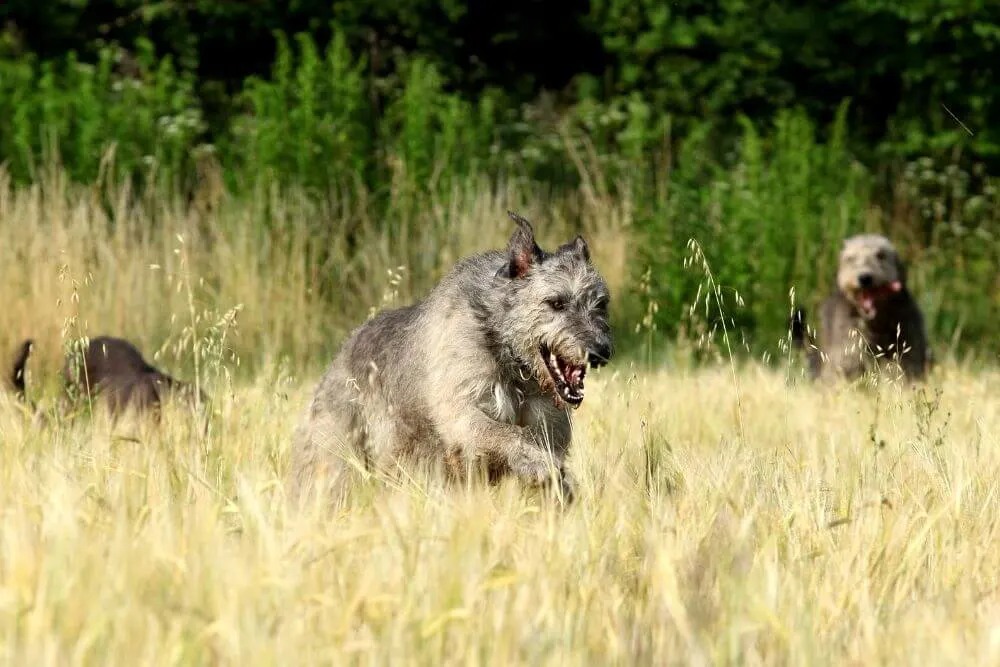
Irish Wolfhounds were bred to take down large and powerful prey, such as packs of wolves that hunted across the landscape of Ireland. It is little wonder that they earned the name of Irish Wolf Dog.
They would also have been used to hunt other animals such as wild boar and deer.
(The Giant Irish Elk was probably extinct by the time the Wolfhounds arrived in Ireland).
While one single Irish Wolfhound can be a powerful force to be reckoned with, when combined with another Irish Wolfhound or other dogs, they became a particularly efficient and lethal hunting team. Irish Greyhounds were often used in combination with Irish Wolfhounds.
These powerful dogs, known for being hardworking and independent, were able to use speed, agility and intelligence to react quickly in the middle of the hunt.
Rather than track their quarry by scent, like many other dogs, Irish Wolfhounds are sight hounds and rely on their vision to hunt.
Wolves in Ireland
To keep the number of wolves in check, each county in Ireland was required to keep a specific number of Irish Wolfhounds.
For the English Wolfhounds became trophy possessions and gifts to royalty and nobles of Europe, which caused a decline in the number of animals used to defend and protect the lands in Ireland.
The numbers started to dwindle so much that Oliver Cromwel, (the English military officer who was in charge of the attempts to reconquer Ireland after several rebellions around the 1640s and 1650s,) put a ban on the export of Irish Wolfhounds.
By the time Cromwel came to Ireland, wolves in England had been a very rare sight since the early 16th century.
In an attempt to hasten the eradication of wolves in Ireland he placed a very high bounty on them.
This plan took time but did work and the last wolf was killed in Ireland around 1786.
Without the threat of wolves, the need for large numbers of Irish Wolfhounds was no longer so strong.
These large breed dogs were confined to a small number of wealthier families in Irish society, such as the chieftains and their descendants.
Over time, these status symbol dogs declined to a point of almost extinction.
Modern Irish Wolfhound
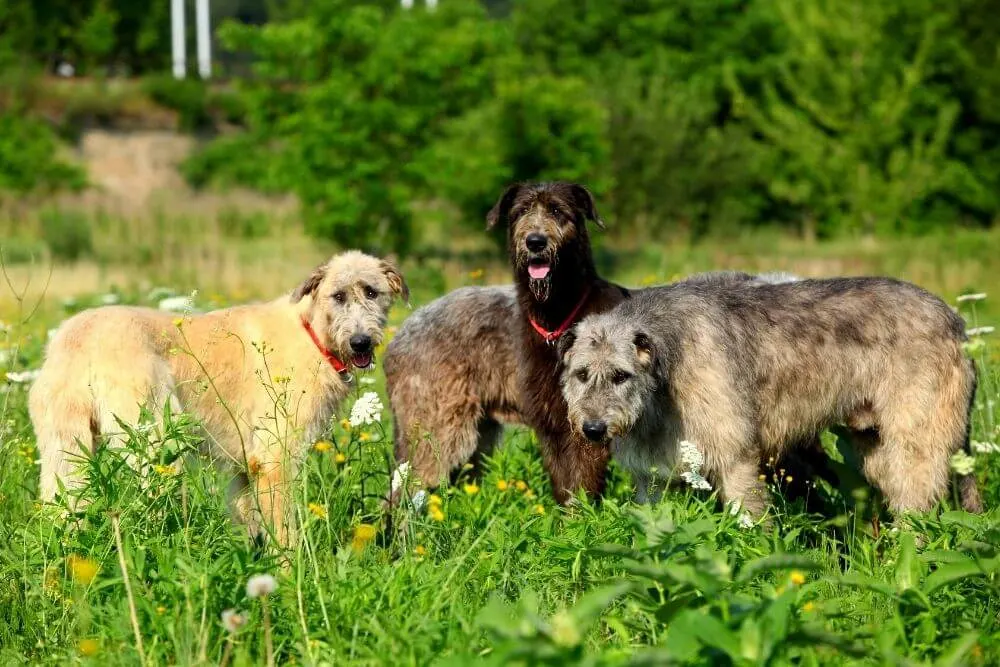
Around 1864, Captain George Augustus Graham started to become interested in the Irish Wolfhound and their plight. He was an experienced dog, who decided to focus his attention on this near extinct breed.
At this point in time, no one knew exactly how an Irish Wolfhound looked as there were many different depictions of them in art.
There was not even a consensus on their size.
There is little archeological evidence to support the idea that the size of dog that we are familiar with today existed before about 1000 CE.
Based on the few remaining specimens that he could find and an idea of what he thought the breed should look like, Graham started to breed Irish Wolfhounds, by outcrossing it with other breeds.
These included the closely related Scottish Wolfhound (Deerhound), as well as Russian Borzoi, Great Danes, English Mastiffs and Tibetan Kyi Apso.
The result of these breeding attempts can be seen in the Irish Wolfhounds that we know and recognise today.
At first it was difficult for the breed to get recognized.
Many people did not agree with the degree of outcrossing found in the new modern Irish Wolfhound and believed that the true Irish Wolfhound bloodlines were so watered down that the breed could not call itself by the Irish Wolfhound name.
However, eventually the breed slowly started to become accepted around the 1880s, with the first Irish Wolfhound Club being founded in 1885.
In 1897, the American Kennel Club recognised the Irish Wolfhound and acceptance of the Irish Wolfhound breed slowly increased after this.
Irish Wolfhounds as a Symbol of Ireland
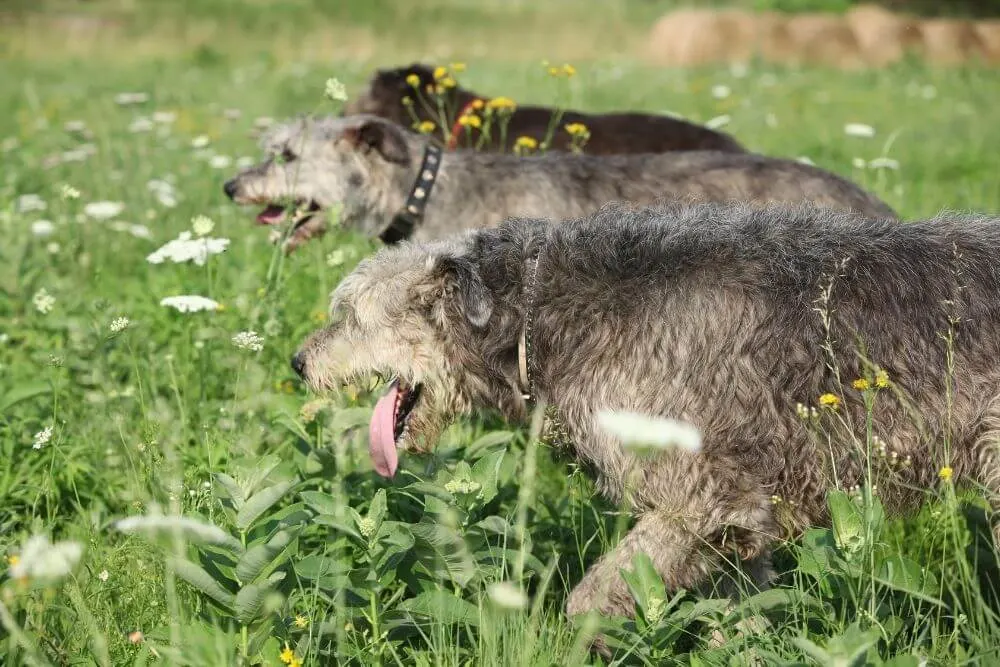
The end of the 19th and beginning of the 20th century saw great changes in Ireland.
The momentum for Irish independence from Britain, as well as clear Irish identity came to the fore.
(Other Irish dog breeds such as the Irish Terrier and the Kerry Blue Terrier also experienced dramatic changes in their popularity in connection with Irish Independence at this time as well.)
Irish Wolfhounds have been long associated with Ireland and have been romanticized in history.
However, while many Irish nationalists claimed the Irish wolfhound as a true symbol of Ireland, the stark reality was that without the recent help of the English breeder, Graham, the breed may have died out by then.
In order to increase the popularity of the breed and gain wider acceptance of the breed both in Ireland and Britain, Graham suggested that an Irish Wolfhound should be used as the mascot of the Irish Guards regiment.
The idea was a successful one and did help to increase the popularity of Irish Wolfhounds.
Ever since 1902, the Irish Guards (one of the foot Guards of the British Army) has always had one Irish Wolfhound as their mascot, which leads them when they are on parade.
From 1928 until the introduction of the decimalization of the currency in Ireland, the sixpenny piece featured an Irish Wolfhound.
It was one of the animal designs in the Barnyard Collection by Percy Metcalfe. While some of the other animals were later featured on the face of the new decimal coins, the Irish Wolfhound did not.
In 2012, the Central Bank of Ireland released a special commemorative €15 coin with an Irish Wolfhound and a young pup that was designed by Emmet Mullins.
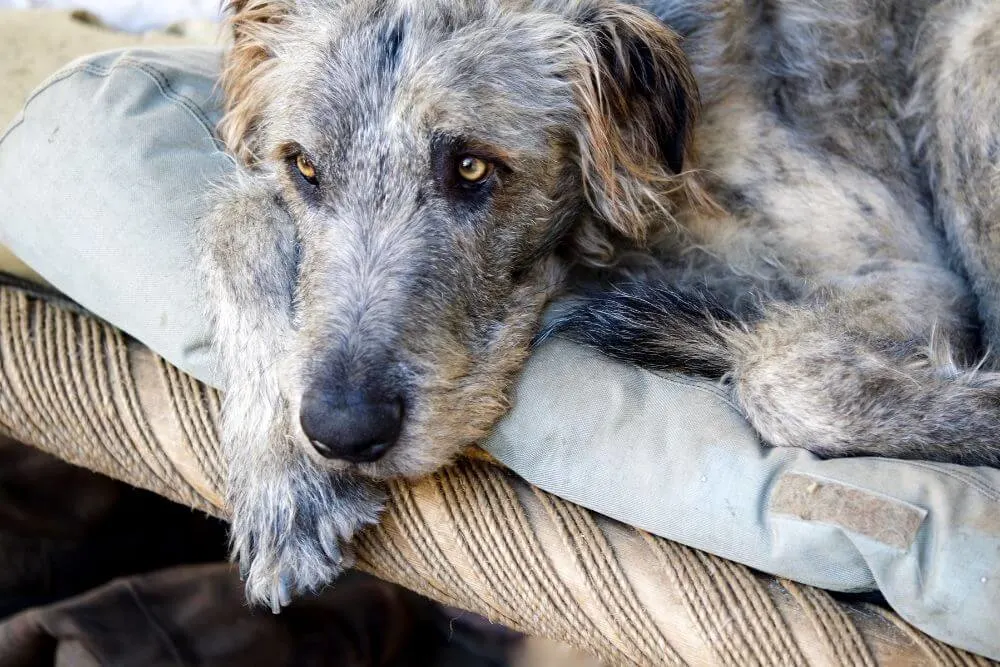
Did you know?
Irish Wolfhounds have been used on several logos, emblems and sporting bodies through the years, including the original emblem of the Abbey Theatre in Dublin, on Irish revenue tax stamps and is the nickname of the National Rugby League Team (“Wolfhounds”).
Irish Wolfhounds Today
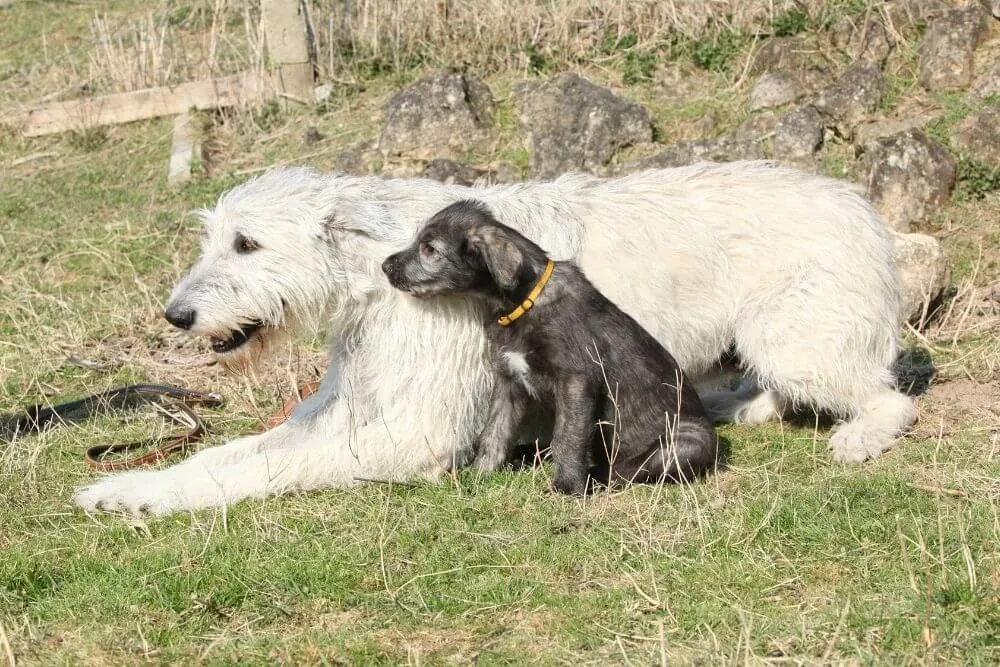
Although they are not very common, Irish Wolfhounds are a popular breed of dog (number 85 in the AKC ranking list in 2021) with many devotees.
Many of these enthusiasts help to strengthen and popularize the breed in the form of breed clubs throughout the world.
(For information about dog shows and canine sports events for Irish Wolfhounds, the breed clubs are a great source of uptodate information and resources relating to Irish Wolfhounds.)
For fans of Irish Wolfhounds, there are many different types of gifts and tokens featuring Irish Wolfhounds.
Many breed clubs offer such merchandise to help with the running costs of the clubs and it is a helpful way to support them if you can.
The striking appearance of these dogs is so impressive that it is likely to leave a lasting impression. It is certainly hard to forget the experience of the first time you encounter one in real life!
Dog Breeds Irish Kennel Club
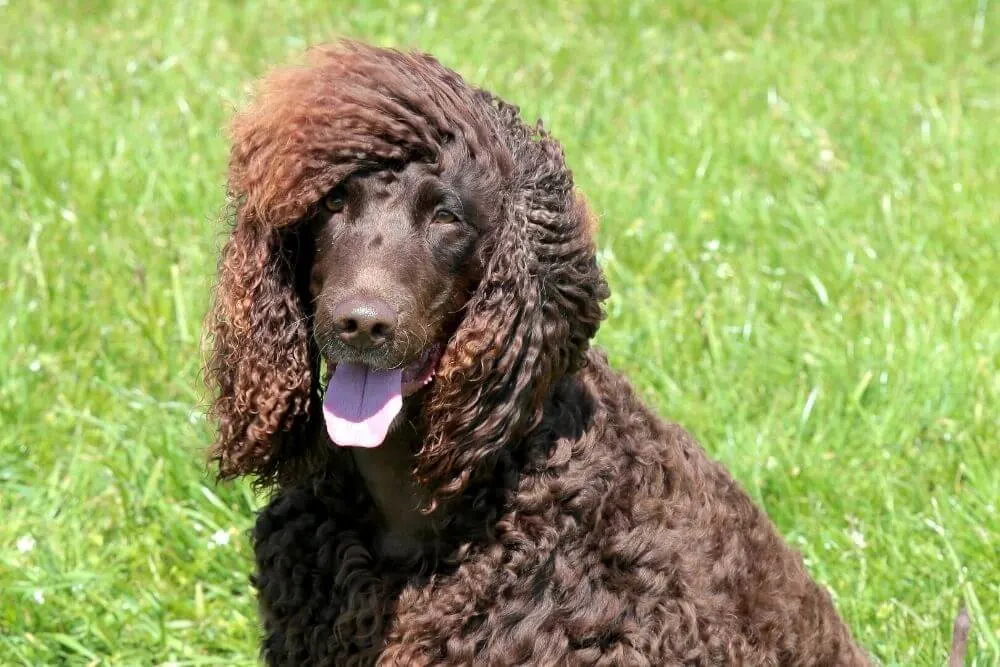
The Irish Wolfhound is just one of the nine dog breeds recognised by the Irish Kennel Club.
Irish Wolfhounds are by far the largest, while the smallest are the fearless Glen of Imaal Terriers.
If you fancy getting a book on Irish dog breeds, then “The Curious History of Irish Dogs”, will give you some great insights into the development of these breeds in Ireland and how intertwined with Irish history these dogs are.
For detailed information about the other Irish dog breeds, including the one other Irish hound dog, the Kerry Beagle, please check out the following links.
- Kerry Beagle
- Irish Terrier
- Kerry Blue Terrier
- Irish Soft Coated Wheaten Terrier
- Glen of Imaal Terrier
- Irish Water Spaniel
- Irish Setter
- Irish Red and White Setter
For a general overview of all the 9 breeds, check out the Guide to Irish Dog Breeds, it might also give you some inspiration for some Irish dog names!
Dog lovers might also want to check out our Irish Doodle article. Although not a recognised breed, this Irish Setter Poodle cross is gaining popularity as a family dog.
This article may contain affiliate links. If you click on one of these we may receive a small commission at no extra cost to you. Thank you for your support.
Please note that this article is only for general information purposes about the Irish Wolfhound breed and should not be used as a substitute for canine health information, as well as medical and pet care advice from veterinary specialists.

(Irish Nature Expert and Celtic Enthusiast from Ireland)
Emer Walker, founder of LetsGoIreland.com, is a Cork native with profound expertise in Irish nature and ecology. Holding a PhD in Restoration Ecology and backed by extensive research in ecological sciences, she’s delved deep into Ireland’s natural wonders, from its rugged landscapes to its serene beaches. Emer’s passion also encompasses Celtic art and traditions. As a true authority on Ireland’s natural and cultural heritage, she invites readers through LetsGoIreland.com to immerse themselves in the authentic Irish experience.
